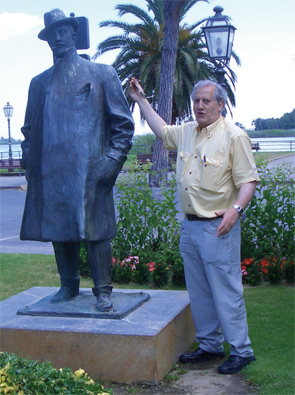
Begin a conversation with Theodore Pincus, MD, about his scientific career, and you’ll soon be discussing a range of topics, from the history of rheumatology to Edward Gibbon’s The Decline and Fall of the Roman Empire. “The thing about Ted is that he is an effervescent person,” says Halsted R. Holman, MD, who was chair of medicine at Stanford University’s School of Medicine when Dr. Pincus became an internal medicine resident in the early 1970s and is now the emeritus Guggenhime Professor of Medicine there. “He has great enthusiasm about whatever he’s into.”
Dr. Pincus’ far-reaching intellectual curiosity has taken him down many paths in his 40-plus years in medical science. He is currently a professor of both medicine and microbiology at Vanderbilt University in Nashville, Tenn., reflecting his decades-long interests in both basic science and clinical medicine. He is well known among his rheumatology colleagues for his discovery of the association of education with outcomes in RA, and known worldwide for his tireless advocacy for the value of a patient self-report questionnaire such as the Health Assessment Questionnaire (HAQ) in assessing and documenting patient status, course, and outcomes.
“If you look at the movement to evaluate outcomes of management in chronic disease, Ted was in on the beginning of it,” says Dr. Holman. “And, if he wasn’t the first one, he was clearly the most effective in showing the relationship of patients’ education to outcome.”
Frederick Wolfe, MD, director of the National Data Bank for Rheumatic Diseases in Wichita, Kan., and a long-time collaborator with Dr. Pincus, agrees. “He has certainly been the most important proponent for the use of self-report questionnaires in clinical practice.”
How did Dr. Pincus become, as he calls it, “a disciple of the HAQ”? The story does not unfold in a straight trajectory. But then, neither did his career path.
[Dr. Pincus] has certainly been the most important proponent for the use of self- report questionnaires in clinical practice.
From Surgery to Immunology
From his days as an undergraduate at Columbia University in New York City, Dr. Pincus had been interested in analyzing the nature of antibodies involved in immune complex disease. One mentor, Charles Christian, MD, then the head of rheumatology at Columbia, had employed him in his laboratory while he was an undergraduate student.
After receiving his medical degree in 1966 from Harvard Medical School, Dr. Pincus began a surgical residency. But history intervened: It was the time of the Vietnam War, and he joined the Public Health Service to work at the National Institutes of Health (NIH) in lieu of active military duty. While at the NIH, he conducted immunology research under the directorship of Norman Talal, MD, and devised a simpler version of an earlier DNA antibody test that could be used in the clinic to diagnose lupus. “And it worked!” says Dr. Pincus. “That study was published in The New England Journal of Medicine in 1969 and actually, in a sense, set the stage for the rest of my career.”
Stanford and Beyond
After his four years of public health service at the NIH, he applied for an internal medicine residency at Stanford. He recalls that Dr. Holman was very gracious about his application and did not require any “remedial” training (as other programs had suggested) after his hiatus from a surgical residency. “That was no problem,” says Dr. Holman. “We didn’t believe in disciplinary lines or required training programs or the like. It was no problem for us to take a smart, engaging surgeon and say, ‘OK, you want to be a doctor in medicine? That’s fine with us.’ ”
In the early 1970s, rheumatology was just emerging as a distinct discipline, “We were interested in people who brought skills and potentially different valuable ideas,” says Dr. Holman, “and [Dr. Pincus] fit right into that category.” After Stanford, Dr. Pincus returned to Cornell for his second year of residency to be near Dr. Christian, who had moved from Columbia to the Hospital for Special Surgery. When he applied for a rheumatology fellowship, he was told that Robert Good, MD, PhD, at Memorial Sloan-Kettering was offering a position as assistant professor in molecular virology research, which paid $15,000 more than a fellowship. With a new baby to provide for, Dr. Pincus opted for the assistant professorship.
He continued his work on deciphering genetic control of viruses at the cellular level at the University of Pennsylvania’s Wistar Institute in Philadelphia as a professor in molecular virology, where was gradually introduced to the joys of clinical work.

Treasure in a Jim Beam Carton
In 1980, Dr. Pincus accepted an invitation to develop a rheumatology program at Vanderbilt University in Nashville, and began commuting from Philadelphia to Nashville every Wednesday. Coincidentally, in April of that year, James F. Fries, MD, professor of medicine at Stanford University School of Medicine (Calif.), first publication of the HAQ appeared in Arthritis & Rheumatism. In fact, Dr. Pincus recalls reading the article on the plane to Nashville: “I regarded this as a clinical tool that might improve clinical medicine.”
He immediately began using the questionnaire in his clinics. “I’ve always been interested in measurement in clinical care,” he says. “That’s what my DNA test was about: measurement. So I’ve always been sort of a ‘quant.’ ”
In 1982, Dr. Pincus inherited a box of records from William Sale, MD, an orthopedic surgery resident who was leaving the university for private practice. Filed inside a carton bearing a Jim Beam whiskey label were records from 75 patients with RA whom Dr. Sale had studied and assessed in 1973.
“That was very far-sighted,” says Dr. Pincus. “I had nothing to do with the assessment, but it included a whole list of questions about daily living as well as joint exams—basically what we do today, but with a less developed methodology.”
The patients had received injections of thiotepa, an antineoplastic alkylating agent. Dr. Pincus was curious how these patients had fared in the nine intervening years because of concern that there might be an increased risk of cancer associated with alkylating agents. He enlisted the help of a medical student, who contacted the patients whose records were in the box. A physical therapist gave Dr. Pincus lessons on performing function measures (grip strength, walking time, and button test), and he began the follow-up with these patients on Saturdays.
Interestingly, Dr. Pincus was able to account for all 75 of the original study patients. “In a way, we were lucky,” he says, “because this part of Tennessee had less population mobility than, say, California and New York.” But even more startling were the results from their efforts. Of the original 75 people, 20 had died—a statistically-significantly higher number than what would have been expected. He also noted severe declines in functional status for almost all the remaining patients. These two findings contradicted the conventional wisdom of the time (based on population studies) that RA was not a severe disease. He also found that premature death in RA could be predicted by two unexpected variables: functional status, as documented on Dr. Sale’s precursor HAQ, and education level.
This was the eureka moment for Dr. Pincus: Outcomes for people with RA could be better predicted by questionnaires than by X-rays or lab tests. His first paper about his findings was initially rejected by many journals; it was then that he realized that promoting the questionnaires as both clinical and research tools would be a struggle.
“I really thought that as soon as I told the world about this thing with the questionnaires that everybody would start using them,” he recalls. “In a sense, the questionnaire was a marker like blood pressure or cholesterol: It could predict premature death.”
He took a three-month sabbatical from his lab to rewrite the paper and refine its methods. The three months turned into 26 years. “I never thought I’d be sitting here, still struggling to convince people to use this,” he says. “I thought I would be honored—well, I am honored by this telephone call. I really couldn’t believe that people didn’t use this questionnaire, and I became a proselytizer for its use.”
A Bad Rap for Questionnaires?
Dr. Pincus modified the original HAQ to make it shorter and easier to use in clinical practice. In 1985, he used modern measures to do a repeat of the 1973 Sale study and found that the questionnaire was the best predictor of death in patients with RA at five years post-assessment. In subsequent decades, he has repeatedly proven that the multidimensional HAQ (MDHAQ) is as robust in predicting patient outcomes as the longer version.
The issue of doing outcome measurement for chronic diseases within the context of the individual practice has not been settled to this day, notes Dr. Holman. “When Ted began to deal with the HAQ in the 1980s, doctors—myself included—were very reluctant to add this into our practices. It added a dimension of work that you weren’t reimbursed for, and most people didn’t know how to use it.”
Dr. Holman believes a large part of the resistance stems from medical education’s cleaving to the acute disease rather than the chronic disease model. This transformation in medical education is still in its infancy, he says.
Yusuf Yazici, MD, assistant professor of medicine at New York University Hospital for Joint Diseases, first met Dr. Pincus after a talk he gave at the World Trade Center in 2000, and was convinced to incorporate questionnaires into his practice. “I was just finishing training and starting out, so it was easier to do than to change to another system [of patient evaluation],” says Dr. Yazici.

He believes physicians and patients may have a negative association with questionnaires because of the exhaustive instruments employed in clinical trials. “For them, ‘questionnaire’ means two hours of sitting down with someone to fill it out,” he says. “In the questionnaire that Dr. Pincus has devised, the shorter, simplified version is as robust as the full-length clinical trial questionnaire. And it’s much simpler and more straightforward to use.”
Drs. Pincus, Yazici, and Martin Bergman, MD, a rheumatologist at Arthritis and Rheumatology in Ridley Park, Pa., presented a study at an ACR meeting documenting their comparison of the standard versus the MDHAQ. Each physician scored a HAQ, which took about 42 seconds. Then he or she scored the MDHAQ, which took 7.5 seconds. Dr. Pincus voiced frustration that despite results such as these, the HAQ or MDHAQ is not used more often as a clinical management tool. “It is curious that many rheumatologists say that they ‘don’t have time’ to use a questionnaire in patient care,” Dr. Pincus says. “I don’t have time not to use the questionnaire. … Our questionnaire saves me at least three minutes per patient—sometimes more.”
Undaunted, he continues to travel internationally, speaking and collaborating with researchers. With his indefatigable drive to advance the cause of patient self-report, Dr. Pincus keeps a full calendar of teaching, research, and travel. He has friends and colleagues all over the world, and he enjoys hiking in the woods near Nashville to relax. He often travels to Denver to spend time with his daughter and grandchildren. He’s also a lover of the opera (his current favorite is Johann Strauss’ “Die Fleidermaus”) and of the New York Times crossword puzzles.
With a reputation for straightforwardness, Dr. Pincus often cuts a colorful figure at meetings. Dr. Yazici finds this refreshing, and is impressed with Dr. Pincus’ strong opinions balanced by his approachability. “He won’t beat around the bush, so you know what he is thinking at all times,” Dr. Yazici. “But I think that’s a much better way to do business.”
Dr. Wolfe, also an avid advocate for and practitioner of patient self-report (he has used questionnaires for every patient he’s seen since 1974), has forged a strong personal and professional bond with Dr. Pincus. “Everywhere you go, you see Dr. Pincus telling people how important it is to use self-report questionnaires in clinical practice.”
If he is a restless spirit in his quest, Dr. Pincus is also a generous one. “Each year he edits supplements to medical journals summarizing the rheumatology literature,” says Dr. Wolfe. “He is selfless in doing all these things. He’s a very generous spirit, and he would go out of his way to help people. I think he’s a very good man. I’m glad that I’m friends with him and that he’s willing to have me as a friend.”
Gretchen Henkel is a medical journalist based in Los Osos, Calif.
Career
1966–Graduates from Harvard Medical School in Boston. Completes a one-year surgery internship at Massachusetts General Hospital, Boston.
1967–Serves as staff associate at the U.S. Public Health Service of the National Institutes of Health.
1972–Completes a one-year internal medicine residency at Stanford University.
1973–Completes a one-year internal medicine residency at Cornell-New York Hospital.
1974–Completes a one-year internal medicine fellowship at Memorial Sloan-Kettering Cancer Center in New York.
1976–Accepts position as adjunct associate professor of medicine (rheumatology) at the University of Pennsylvania School of Medicine in Philadelphia.
1980–Accepts position as professor of medicine and microbiology and chief of rheumatology and immunology at Vanderbilt University School of Medicine in Nashville, Tenn.
1992–Steps down as chief of rheumatology and immunology at Vanderbilt.
